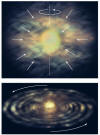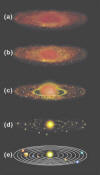Formation of the Solar System
Nebular-Condensation theory
- Our solar system formed about 4.6 billion years ago.
- Nebular Theory: Our solar system evolved from a
contracting nebula.
- Under the influence of
its own gravity, the nebula contracts. As it contracts, it spins faster
and faster, much like an ice skater who pulls in her arms. This effect
is known as conservation of angular momentum. As a result of the
spinning, the nebula flattens out to form a disk, much like a clump of
dough which is spun into a pizza.
- As it continues to
flatten and spin, the nebula becomes denser and hotter, particularly in
the center. The dense, hot center eventually forms into a star, the Sun.
- The swirling mass
destined to become our solar system is usually referred to as the
solar nebula.
- Condensation Theory: An extension
of Nebular Theory that incorporates interstellar dust as a key ingredient.
- The
solar nebula is initially a thin gas of hydrogen and helium strewn with
tiny dust particles.
These tiny grains serve as the building blocks of the planets.
- Dust grains play an important role in the evolution of any gas
cloud. These grains act as condensation nuclei, on which
accretion of matter occurs.
- Analogy#1: Snowball moving through a fierce snowstorm grows bigger
as it encounters more snowflakes. Analogy#2: Raindrops form in Earth's
atmosphere, as dust and soot in the air act as condensation nuclei
around which water molecules cluster.
- Clumps of matter form around the condensation nuclei. These clumps
collide, stick together, and grow into moon-sized planetesimals. Planetesimals coalesce into a few protoplanets.
- High-speed collisions also result in fragmentation, with the creation of
asteroids and comets.
- Protosun and 9 protoplanets developed after 100 million years.
- Interplanetary debris swept away after a billion years through:
- Collisions with planets
- Gravity-assisted ejection
- Radiation pressure
- Solar wind
- Evidence for Condensation Theory includes:
- Observations of circumstellar disks
within various nebulae.
- This captivating
video zooms in on the consteallation Taurus to reveal a very
young star,
HL Tauri, surrounded by protoplanetary disk.
- Stars containing larger fractions of "dusty" elements, such as
carbon and silicon, are more likely to have planets.
- Computer simulations demonstrating that
many orbiting particles can, after multiple collisions, form a few
stable orbits.
- This
video tutorial does a nice job demonstrating all this visually.






Composition
- The ingredients of the solar nebula fell into 4
categories based on their condensation temperatures: metals, rocks, hydrogen
compounds (water, methane, ammonia), and light gasses (hydrogen and helium).
- Distance of a planet from the Sun determined the temperature and thus the
materials which condensed first.
- Metals condensed first, then rocks, then the
lighter compounds, then the light gasses.
- The dense Terrestrial planets formed closer to the Sun because only
the heavy elements condensed in this relatively hot region.
- Farther from the Sun, the Jovian planets formed first by the
condensation of a dense core and then by a thick outer layer of light
gasses.
- This condensation-based separation of heavy and light elements
explains why the terrestrial planets are
enriched in the heavier elements
compared to the Universe as a whole.
- The asteroid belt region coincided with the frost line. Before the frost
line, rocks and metal condense; hydrogen compounds stay vaporized. After the
frost line, hydrogen compounds also condense.
- Our Moon most probably formed through a collision with a Mars-sized object.




Moons
- Most moons in our solar system probably formed together with their host planet
(co-accretion).
- Some of the smaller moons, particularly those with irregular orbits
('wrong plane and/or direction), may have been captured.
- Our Moon probably resulted from a massive
collision.
- Triton, Neptune's largest moon, is the only large moon with a retrograde
orbit. It was probably captured from the Kuiper belt.




